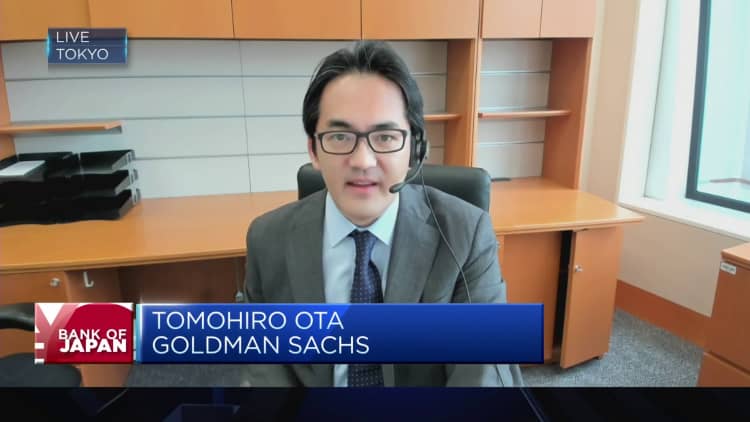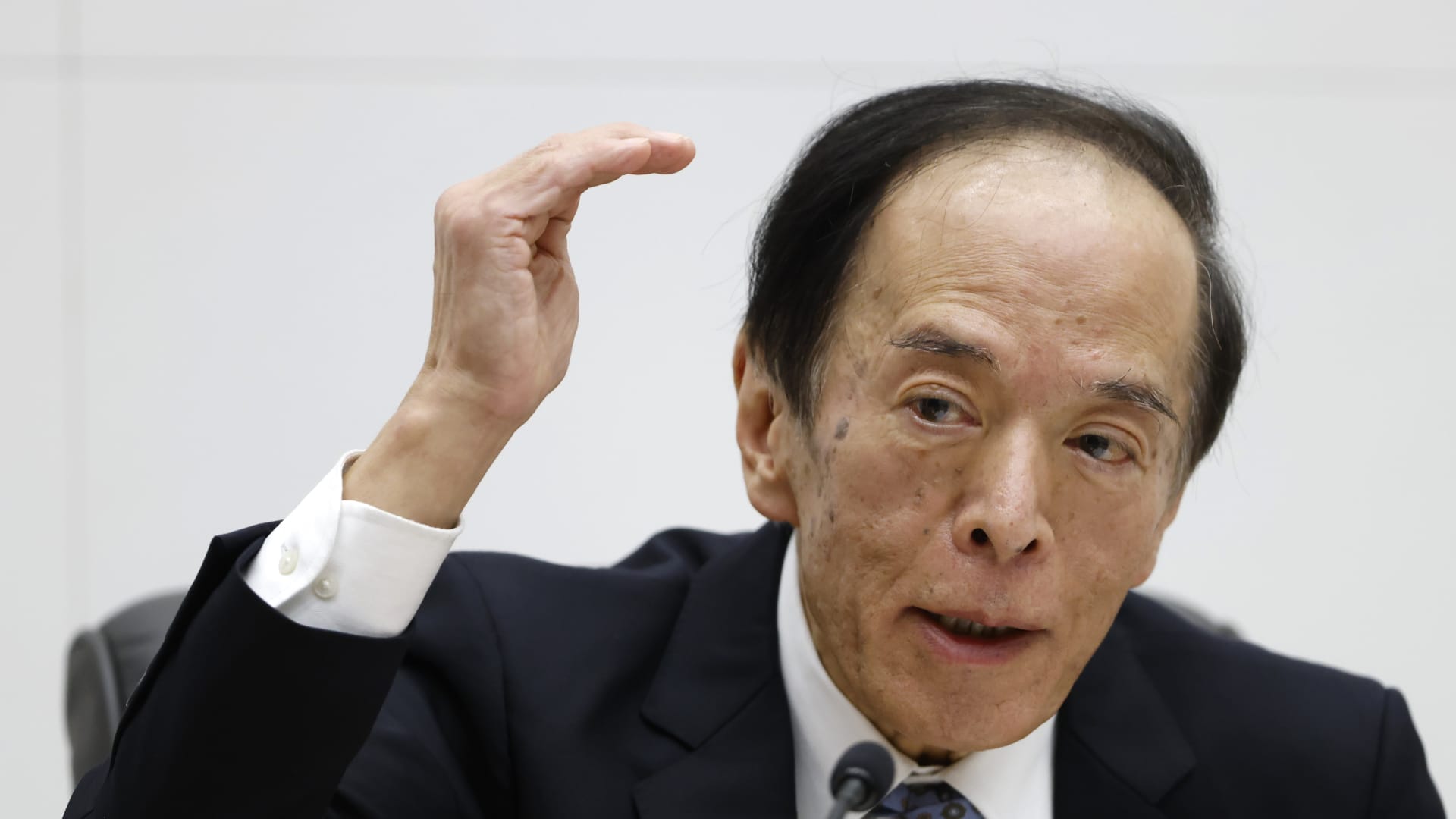Kazuo Ueda, governor of the Bank of Japan (BOJ), gestures as he speaks during a news conference at the central bank’s headquarters in Tokyo, Japan, on Tuesday, Oct. 31, 2023.
Kiyoshi Ota | Bloomberg | Getty Images
Japan’s central bank left its ultra-loose monetary policy unchanged at its final meeting this year, a move that unraveled the recent yen rally as the Bank of Japan chose to wait for more concrete signs of meaningful wage growth.
The Bank of Japan decided unanimously to keep interest rates at -0.1%, while sticking to its yield curve control policy that keeps the upper limit for 10-year Japanese government bond yield at 1% as a reference, according to a policy statement released Tuesday.
“Uncertainty over the outlook is extremely high and we have yet to foresee inflation sustainably and stably achieve our target. As such, it’s hard to show now with high degree of certainty how we can exit [from ultra-loose policy],” Ueda said Tuesday afternoon at a press conference, according to a Reuters translation.
“If we were to exit negative rate, interest rates will rise slightly. But inflation-adjusted real borrowing costs will remain low, so accommodative monetary conditions will be sustained,” he added.
Yields for the 10-year Japanese government bond fell to 0.622%, and the yen weakened after the BOJ decision, and was trading more than 1% lower at 144.33 against the greenback in the late afternoon. The Nikkei 225 stock index climbed 1.4% to its highest closing level in nearly two weeks.

Yen weakens after BOJ maintains ultra-loose policy
Comments from Ueda earlier in December had raised expectations of a change in monetary policy, sparking a rally in the yen. Japan’s central bank has been cautious in unwinding its long-held ultra-loose monetary policy, wary that any premature move could jeopardize recent nascent improvements.
In all, the BOJ progressively loosened control of 10-year Japanese government bond yields three times in the last year — last December, in July and October.
Wage growth
With the BOJ’s possible unwinding of its ultra-loose monetary policy being challenged by a slowing economy and cooling inflation, most economists expect Governor Kazuo Ueda to only make changes next year, once the annual spring wage negotiations confirm a trend of meaningful wage increases.
“Even if real wages are falling year-on-year, if we expect wages to rise ahead and consumer inflation to continue slowing, that could turn real wages positive,” Ueda said.

“If there are prospects that real wages will turn positive due to these factors, the underlying decline in real wages won’t be an impediment to normalizing policy,” he added.
Japan’s umbrella labor union, Rengo, said in October that it would demand wage hikes of at least 5% at next year’s spring wage negotiations. The union managed to secure the biggest raise in three decades at this year’s talks in March.
We won’t decide policy on the thinking that we would need to rush just because the Fed could move three, or six months ahead.
“Executives of some big firms are commenting on prospects of higher wages,” Ueda said. “Our hearings, however, show many companies have yet to decide next year’s wage policy due to high economic uncertainties.”
“Some smaller firms appear to be struggling to pass on higher raw material and labor costs. The chance of trend inflation accelerating towards our price target is gradually heightening. But we still need to scrutinize whether a positive wage-inflation cycle will fall in place,” Ueda added.
Inflation outlook
On Friday, the Japanese central bank also said it expects core inflation — which it defines as inflation that excludes food prices — to stay above 2% through fiscal 2024. Despite core inflation exceeding its stated 2% target for 19 consecutive months, the BOJ has “patiently continued” with its super accommodative monetary policy.
The so-called “core core inflation” — inflation minus food and energy prices — has exceeded BOJ’s 2% target for 13 straight months now.

For the BOJ, the preference is for inflation in Japan to be driven by domestic demand, which is more sustainable and stable. The bank believes wage increments would translate into a more meaningful spiral, encouraging consumers to spend.
However, high inflation is starting to adversely impact consumer spending in Japan. This contributed to Japan’s first quarterly economic contraction in more than three years in the July to September quarter, shrinking 2.9%, according to revised government data released Dec. 8.
The BOJ’s monetary policy is complex and multi-faceted due to the various quantitative easing tools it has used to reflate the world’s third-largest economy in the last three decades.

Its super-easy posture also sets it apart as an outlier at a time when other major central banks have raised rates to combat stubbornly high inflation. This policy divergence has partly accounted for pressures on the Japanese yen and government bonds.
Still, Ueda said any U.S. Federal Reserve’s decision to start easing would not directly influence the BOJ’s policy making.
“If the Fed were to shift to a rate cut cycle, the background in which such a decision would be made would have an impact on Japan’s economy such as through currency moves and the chance of a U.S. soft landing. But we won’t decide policy on the thinking that we would need to rush just because the Fed could move three, or six months ahead,” he said.

